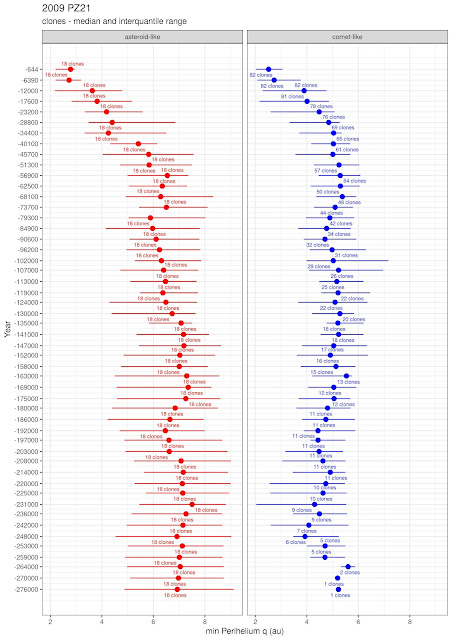Clones generation
| Clones | Target | ||||
|---|---|---|---|---|---|
| mean | sd | mean | sd | ||
| q | 3.85914782817777 | 2.37290442662423e-07 | 3.85914783140272 | 2.3537e-07 | |
| e | 0.0801406801559403 | 6.09227507904535e-08 | 0.0801406839559804 | 6.2114e-08 | |
| i | 17.137419366797 | 6.36351406517114e-06 | 17.137419930196 | 6.2706e-06 | |
| peri | 320.523142499568 | 5.99473078348146e-05 | 320.523140865999 | 5.9474e-05 | |
| node | 307.443365230246 | 2.42363482614464e-05 | 307.443369025924 | 2.384e-05 | |
| tp | 2460899.33667196 | 0.000556445464595854 | 2460899.33668632 | 0.0005656 | |
100 clones were generated to match the nominal orbital parameters (and uncertainty) of asteroid 2009 PZ21 (orbit condition code 0 - last observed in Feb 2022).
Backward simulation
Mercury 6 parameters:
)O+_06 Integration parameters (WARNING: Do not delete this line!!)
) Lines beginning with `)' are ignored.
)---------------------------------------------------------------------
) Important integration parameters:
)---------------------------------------------------------------------
algorithm (MVS, BS, BS2, RADAU, HYBRID etc) = BS
start time (days)= 2459600.5
stop time (days) = -1d8
output interval (days) = 100
timestep (days) = 0.05
accuracy parameter=1.d-12 ... ejection distance (AU)= 100
Simulation results
- 82 out of 100 clones arrived into the solar system from a distance greater than 100 AU, most of them about 54000 years ago (below they are flagged as being on a 'comet-like orbit')
- the remaining 18 out of 100 asteroids are flagged as being on an 'asteroid-like' orbit
Plots
In the following plots, the simulation time has been divided into 50 slots and the relevant orbital inter-quartile distribution of the contributing clones is shown:
Best wishes,
Alessandro Odasso










No comments:
Post a Comment
Note: Only a member of this blog may post a comment.